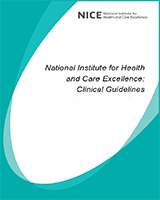From: Hypertension in pregnancy: diagnosis and management

NCBI Bookshelf. A service of the National Library of Medicine, National Institutes of Health.
| Degree of hypertension | ||
|---|---|---|
|
Hypertension: blood pressure of 140/90-159/109mmHg |
Severe hypertension: blood pressure of 160/110mmHg or more | |
| Admission to hospital | Admit if any clinical concerns for the wellbeing of the woman or baby (see recommendation 1.5.2) or if high risk of adverse events suggested by the fullPIERS or PREP-S risk prediction models | Admit, but if BP falls below 160/110 mmHg then manage as for hypertension |
| Antihypertensive pharmacological treatment | Offer pharmacological treatment if BP remains above 140/90 mmHg | Offer pharmacological treatment to all women |
| Target blood pressure once on antihypertensive treatment | Aim for BP of 135/85 mmHg or less | Aim for BP of 135/85 mmHg or less |
| Blood pressure measurement | At least every 48 hours, and more frequently if the woman is admitted to hospital | Every 15-30 minutes until BP is less than 160/110 mmHg, then at least 4 times daily while the woman is an inpatient, depending on clinical circumstances |
| Dipstick proteinuria testinga | Only repeat if clinically indicated, for example, if new symptoms and signs develop or if there is uncertainty over diagnosis | Only repeat if clinically indicated, for example, if new symptoms and signs develop or if there is uncertainty over diagnosis |
| Blood tests | Measure full blood count, liver function and renal function twice a week | Measure full blood count, liver function and renal function 3 times a week |
| Fetal assessment |
Offer fetal heart auscultation at every antenatal appointment Carry out ultrasound assessment of the fetus at diagnosis and, if normal, repeat every 2 weeks Carry out a CTG at diagnosis and then only if clinically indicated (See section 1.6 for advice on fetal monitoring) |
Offer fetal heart auscultation at every antenatal appointment Carry out ultrasound assessment of the fetus at diagnosis and, if normal, repeat every 2 weeks Carry out a CTG at diagnosis and then only if clinically indicated (See section 1.6 for advice on fetal monitoring) |
Use an automated reagent-strip reading device for dipstick screening for proteinuria in a secondary care setting.
Abbreviations: BP, blood pressure; CTG, cardiotocography.
From: Hypertension in pregnancy: diagnosis and management

NCBI Bookshelf. A service of the National Library of Medicine, National Institutes of Health.